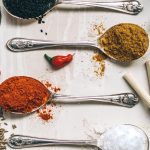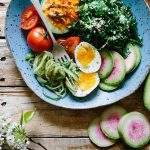Colour has a deeper function and meaning than just appearance. It is because of colour that bees and other insects pose on top of flowers to carry out pollination which gives way to the variety of foods we have today. It is because of colour that our mouths water and our organs squirm in preparation for a feast. It is because of colour that each fruit and veggie is unique, bringing a world of nutrients available at our reach. Still, we forget to bring colour to our plates. Let’s find inspiration in reviewing the cause of colour in food, its benefits and how best to eat the rainbow.
1. Eat Your Greens
From kale and black cabbage to lettuce, chlorophylls are the ones responsible for the green colour present in these veggies. Dark leafy vegetables are rich in iron, which helps carry oxygen through your body; vitamin A, to keep your eyes healthy; complex B vitamins, to keep your energy levels up; vitamin E to maintain healthy and radiant skin; and vitamin K, to keep your coagulation healthy. Greens are also packed with antioxidants. Research indicates that these antioxidants can help prevention various forms of cancer and other chronic diseases.
How to Eat Them
A little heat can actually be helpful to increase the absorption of some nutrients and it can also deactivate some enzymes that lead to oxidation. However, intensive cooking can drain your veggies from their natural green and cause them to lose many of their vitamins, hence the dirty brown colour of veggies when you’ve overcooked them.
Click here for more on eating green.
2. Finding Yellows
Yellow foods are generally characterized by the content of carotenoids, bromelain, limonoids, lutein and zeaxanthins. Yellow foods can aid with the reduction of DNA damage; the elimination of cancer cells; the inhibition of tumours growth; and the strengthening of the immune system.
How to Eat Them
Most of the pigments in yellow fruits and veg are soluble in fat which is why it’s so important to consume them along with a source of dietary fat such as avocado, olive oil, seeds, nuts or fatty fish.
Click here for more on eating yellow.
3. Mad About Orange
Carotenoids are present as crystals or dissolved in lipid droplets to provide food with an orange colour. This pigment is liposoluble, and is therefore better absorbed and used by the body when taken along with other sources of fat such as nuts and oils. Carotenoids are essential for the health of your eyes, your immune system and for your skin.
How to Eat Them
The best way to assure that you get the best allowance of beta-carotenes from your food is by including healthy sources of fat in your meal. Vitamin A intake from raw foods commonly has an absorption rate of about 10% — but when you cook your vegetables it can increase the absorption of vitamin A in your body up to 50%, so it’s always a good idea to add some cooked veg to your plate.
Due to its liposoluble nature it can accumulate on the liver and fatty tissue if taken in isolated forms. Therefore, during pregnancy, it is not recommended to take supplements of vitamin A. As a result, the best way to obtain vitamin A is from the diet or as its precursor form (carotenoids), widely found in orange-coloured foods.
Click here for more on eating orange.
4. Radiant Reds
Anthocyanins are a type of flavonoid, or a group of molecules that can dissolve in water, whereas lycopene is a type of carotenoid — the most famous carotenoid being carotene which colours carrots. Both of these pigments contain antioxidants and produce colours ranging from bright red-orange to blue-violet.
Red fruit and veggies can protect your cells from oxidation and cancer. Other benefits include a healthy heart and eyes and some studies have even signalled that red fruits and veg could aid you in the prevention of degenerative diseases.
How to Eat Them
Instead of white, bland potatoes change to colour! Choose the red, purple varieties or sweet potatoes and get more nutritional value in exchange. Did you know that they are excluded by supermarkets because they are rejected by consumers just because of their colourful nature?
As an alternative of white rice choose the black/purple variety. Their colour is a signal of their nutrient richness. Try these tips to increase your intake of foods with anthocyanins.
- Instead of orange juice swap for tomato juice.
- Try a hibiscus drink which also has diuretic properties.
- Spice up your meal with some chilli which is also rich in vitamin C.
- When was the last time you cooked some eggplant? Make an eggplant lasagne!
- Make your next drink rich in anthocyanins and lycopene by adding beetroot and carrots.
- Sometimes these pigments are hidden and will develop along with the maturity of the fruit — that’s why produce changes colour as it grows, ripens and decays. The ripest, brightest fruit contains the most nutritional value.
Click here for more on eating red.
5. Beautiful Blues
The antioxidant power provided by the colour blue in fruit and veggies comes from the presence of two main chemical compounds: anthocyanins and betacyanines. Anthocyanins are a type of flavonoid or plant metabolite found in pink, red, mauve, violet and blue colours of flowers, fruit and some vegetables. There are six types of anthocyanidins that can be found in nature (pelargonidin, cyanidin, delphinidin, peonidin, petunidin, and malvidin). They can be found in mixtures so that it is not uncommon to find a plant that has several types of anthocyanidins.
The health benefits of anthocyanins come from their strong antioxidant power which allows their radical scavenging activity. Among the health benefits that result from their antioxidant activity are the prevention of inflammatory and cardiovascular diseases as well as a protective effect over several types of cancer.
How to Eat Them
There are some roots and even pulses and cereals that are violet or blue and therefore contain a higher nutritional value than its white counterpart. Some examples include potatoes, corn, rice and beans.
Click here for more on eating blue.
Eat the Rainbow
From green to blue all the colours present in fruit, veggies and some pulses and cereals have a specific health benefit. Combining and alternating the colour in your diet is a way to guarantee your required intake of vitamins and minerals. According to a study done by the Health Survey for England, the risk of death by any cause is reduced by 14% if you eat 1 to 3 portions of fruits and vegetables, 29% for 3 to 5 portions, 36% for 5 to 7 portions, 42% for 7 or more. Add more colour to your plate and you’ll keep on adding more candles to your birthday cake.













